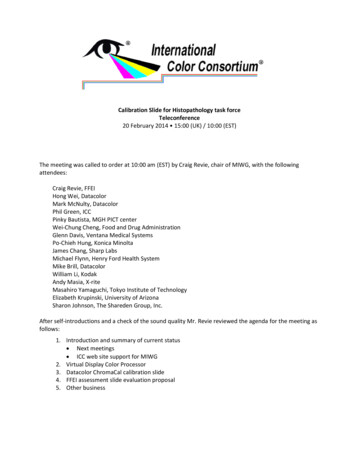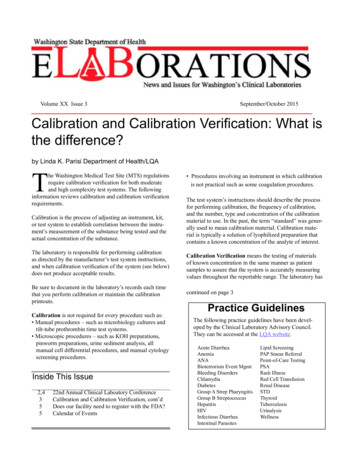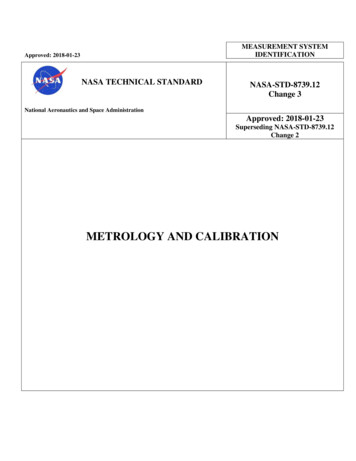
Transcription
Calibration Slide for Histopathology task forceTeleconference20 February 2014 15:00 (UK) / 10:00 (EST)The meeting was called to order at 10:00 am (EST) by Craig Revie, chair of MIWG, with the followingattendees:Craig Revie, FFEIHong Wei, DatacolorMark McNulty, DatacolorPhil Green, ICCPinky Bautista, MGH PICT centerWei-Chung Cheng, Food and Drug AdministrationGlenn Davis, Ventana Medical SystemsPo-Chieh Hung, Konica MinoltaJames Chang, Sharp LabsMichael Flynn, Henry Ford Health SystemMike Brill, DatacolorWilliam Li, KodakAndy Masia, X-riteMasahiro Yamaguchi, Tokyo Institute of TechnologyElizabeth Krupinski, University of ArizonaSharon Johnson, The Shareden Group, Inc.After self-introductions and a check of the sound quality Mr. Revie reviewed the agenda for the meeting asfollows:1. Introduction and summary of current status Next meetings ICC web site support for MIWG2. Virtual Display Color Processor3. Datacolor ChromaCal calibration slide4. FFEI assessment slide evaluation proposal5. Other business
1. Introduction and summary of current status1.1 Next meetingsMr Revie showed details of future MIWG meetings [see attached]. The next full meeting is March 3 inTokyo (see web site for full details). A telecom on Medical Photography is scheduled for March 20 at 15:00GMT (10:00 EST).Subsequently there is a telecon on 17 April (Mobile Displays).Face-to-face meetings will be held on June 19-20 at FDA (co-located with CIE D1 and ISCC Special Topicsmeetings), and on October 30-November 1 in Boston (co-located with CIC and ADP).1.2 ICC web site support for MIWGMr Revie reminded the call of the MIWG web site athttp://www.color.org/groups/medical/medical imaging wg.xalter. The site includes details of futuremeetings, records of previous meetings, listing of activities and participants, and resources relevant to workof the group. A wiki has also been established (details from Phil Green) and MIWG members areencouraged to provide suggestions on how this can be used.2. Virtual Display Color ProcessorMr Wei-Chung Cheng of the FDA presented an outline of an evaluation method for whole-slide imagingsystems [see attached]. He showed the methodology and design philosophy, which included evaluation ofthe capture and display components of the workflow, and described the framework for obtaining colourmeasurements of slides using a spectroradiometer. The test slide is based on a 140-patch ColorCheckerimaged into Fuji Velvia, which is measured.He also showed the Virtual Display Color Processor, which is a hardware interface board that captures theRGB frame data that is sent to the display. He confirmed that the evaluation of the display is against theintended colour space or profile, rather than measurements of the display.Mr Cheng acknowledged that the spectrum of the test slide is different from stains or tissue. The intentionis not to improve calibration or characterization, but to define a common protocol for evaluating theperformance of WSI systems.3. Datacolor ChromaCal calibration slideMr Mark McNulty of DataColor presented a description of the Chromacal calibration system [see attached].The goal of the system is to improve accuracy and consistency. The target of the current system is limitedto transmitted light brightfield microscopy.Chromacal includes calibration software for the digital microscope, a calibration slide, and displaycalibration equipment. Each item is available separately.A range of magnifications are supported by the slide design, and it has the advantage that the whole colourpatch array can be viewed at once in the microscope. Mr McNulty reported that the system provided anaccuracy of around 4 CIELAB E*ab, and made it possible to achieve inter-microscope consistency of around2.8 CIELAB E*ab. He emphasised that Chromacal does not modify the source image but appends thecalibration transform to the file. An audit trail for the adjustments made is available in the system.The calibration slide uses narrow-band interference filters, so is not designated for a single stain protocol.
4. FFEI assessment slide evaluation proposalMr Revie presented an update of the FFEI calibration slide proposal [see attached]. The slide design uses abiopolymer staining technology developed by FFEI and University of Leeds, UK. Slides have a block of 15different combinations of H&E staining protocol and a reference white, together with a block of 9 basestains that are used in many staining protocols.The workflow is separated into calibration of the capture system (using measurements of the calibrationslide as reference), the display RGB data (using the VDCP method) and the physical display (usingmeasurements of the display). An ICC profile is generated from the capture of the reference slide and usedto transform the test slide data to the ICC PCS. Mr Revie also described a visual assessment of the displaycalibration, using the method developed by Yagi and Bautista, illuminating the slide with the displaybacklight.FFEI would like vendors to evaluate this system, and have provided a web site for upload of evaluation data(https://sierra.ffei.co.uk). Mr Revie proposed a round-robin assessment. The group of participants willreview and agree how to publish the results of the round-robin test. A number of vendors andorganisations have already agreed to participate.Mr Masia recommended that multiple measurements and captures should be performed to reduce theeffects of variability on the capture and display systems.Mr Revie confirmed that FFEI have attempted to maximise the life of the reference slide by adding astabilising agent to prevent photobleaching and by carefully selecting the choice of stains.5. Any other businessThere was no other business and the meeting closed at 11.07 EST.A full recording of the meeting is available at gy%20meeting.wmvAction items from the meeting:MIWG web site and wikiMIWG-14-04Provide suggestions for content to Phil Green (all)FFEI assessment slideMIWG-14-05Participate in round-robin test (interested members)Actions from previous meeting:MIWG-14-01Share slides and procedure for testing by other members of the group (Yukiko Yagi)MIWG-14-02Organise circulation of a single slide to vendors with measurement capability for around robin test (Craig Revie)MIWG-14-03Circulate proposal for biopolymer-based calibration slide for consideration by thegroup for consortium funding or other development (Craig Revie).
Calibration slide for histopathologyTeleconferenceFebruary 20th 2014
Calibration slide for histopathologyFebruary 20th 2014 (2-hours teleconference) Introduction and summary of current status(Craig Revie)— Next meetings— ICC web site support for MIWG Virtual Display Color Processor(Wei-Chung Cheng) Datacolor ChromaCal calibration slide(Mark McNulty / Mike Brill) FFEI assessment slide evaluation proposal(Craig Revie / George Hutchinson) Other business
Next meetings Tokyo MIWG meeting (3rd March 13:00-17:00)— followed by a networking reception— local contacts are Masahiro Yamaguchi and Takashi Matsui— teleconference option available – please register with DebbieNext teleconferences – save the date!: teleconference (Medical photography)— 20th March: teleconference (Mobile)— 17th AprilWashington DC (19th and 20th June)— FDA White Oak Conference Center— format will be working group meetings rather than presentationsBoston (30th October – 1st November)— ICC meetings will be followed by ICC DevCon, IS&T Color and ImagingConference (CIC22) and the 2nd International Congress of the InternationalAcademy of Digital Pathology (IADP)
ICC MIWG Web Site: new resources ICC web pages for Medical ImagingDPA Whole Slide Imaging Repository— web page lists sources for whole slide and static image examplesVirtual Display Color Processor codeSPIE Medical Imaging Paper by Tom Kimpe et al.— Does the choice of display system influence perception andvisibility of clinically relevant features in digital pathology images?There is also Wiki support and we could use that for some ofour work in future – contact Phil Green for details
Wei‐Chung ChengDivision of Imaging and Applied MathematicsOSEL, CDRH, US Food and Drug AdministrationWhole Slide ImagingICC Medical Imaging Working Group2‐20‐20141
Not proposing a calibration slide, but an evaluation method Purpose: Evaluating color reproducibility for regulatory purposes “Colorimetrical color difference between digital image and slide truth” Not perceptual difference; not based on optical microscopy For evaluation only, not for calibration/correction Methodology (SPIE MI 2013) consists ofA. Producing the color phantom B. Establishing the truth C. Retrieving the digital display data (SID 2012) D. Calculating the color difference Design PhilosophyLeast burdensome – simple enough to be doable or available for anyone Quantitative (comparing systems and components – intra‐device, inter‐device, inter‐vendor) Objective (universal and repeatable) Flexible ‐‐ mix‐and‐match stages (e.g., C D in‐house, A B outsource) 2
3
Virtual Display Color Processor A circuit for retrieving RGB values from the DVI or HDMI cable Robust digital reading without time‐consuming optical measurement Account for effects of review software/hardware and colormanagement Display can be evaluated as a separate, swappable component4
Cheng, Wei‐Chung, et al. "Assessing color reproducibility of whole‐slide imaging scanners." SPIE Medical Imaging. International Societyfor Optics and Photonics, 2013. Cheng, Wei‐Chung, and Aldo Badano. "70.2: Virtual Display: APlatform for Evaluating Display Color Calibration Kits." SIDSymposium Digest of Technical Papers. Vol. 42. No. 1. BlackwellPublishing Ltd, 2011. Papers and code available at http://code.google.com/p/virtualdisplay/5
Presentation to:ICC Medical Imaging Working GroupFebruary 20, 2014
From Datacolor Mark S. McNulty – General Manager Dr. Michael H. Brill – Director of Research Dr. Hong Wei – Sr. Optical Engineer2
Topics Why calibrate color in digital brightfield microscopy? Imaging workflow and color variability Color calibration system for brightfield microscopy3
Why color calibration for microscopy?4
Basic microscopy workflow Quality of sensor Controls t up Quality of optics Koehler alignment Light sourceCameraset upImageAcquisition Contrast GammaImageAdjustmentImageAnalysis Monitors Publication5Communication
Color management challengeColorReproductionColorCapturing CameraD506
Color management challengeSystem 1System 2 CameraCamera7
Motic Moticam 3MPon Motic AE31Motic Moticam 3MPon Zeiss Axio Lab.A1Uncalibrated Images8QImaging QIClick onZeiss Axio Lab.A1
What is CHROMACAL? Easy to use color calibration system for images fromtransmitted, brightfield microscopes9
Color management solution with CHROMACALTransmission, T(λ), illumination, era: C1,C2,C3Correct cameraC1,C2,C3 to XYZColorCapturingCamera Apply monitor profile:XYZ RGBD50Display: R,G,B10
Color management solution with CHROMACALChromaCalColorCalibration ChromaCalColorCalibrationSystem 1System 2CameraCamera11
CHROMACAL Product Family 1. Calibration system* 2. Calibration slide3. Monitor calibration set* Not for clinical diagnostic use in the U.S.12
The CHROMACAL Workflow Step 1 Capture your specimen images andan image of the calibration slide13
14
The CHROMACAL Workflow Step 2 Calibrate your images with one touch,in single or batch mode15
The CHROMACAL Workflow Step 3 Communicate your calibrated imageson calibrated monitors Monitor calibration is done once, andthen updated periodically16
Motic Moticam 3MPon Zeiss Axio tic Moticam 3MPon Motic AE3117QImaging QIClick onZeiss Axio Lab.A1
Colorimetric Accuracy E00 10.1 E00 9.8 E00 7.3 E00 3.9 E00 2.5 E00 4.0BeforecalibrationMotic Moticam 3MPon Zeiss Axio Lab.A1AfterCHROMACALCalibrationTrue color frommultispectralcamera on ZeissmicroscopeMotic Moticam 3MPon Motic AE3118QImaging QIClick onZeiss Axio Lab.A1
Color ConsistencyQImaging QIClick onZeiss Axio Lab.A1BeforecalibrationMotic Moticam 3MPon Zeiss Axio Lab.A1 E00 4.9AfterCHROMACALCalibrationMotic Moticam 3MPon Motic AE31 E00 2.819
AfterBefore20
AfterBefore21
AfterBefore22
23
Empowering Science with Color Integrity24
FFEI proposal for calibration assessment slidestatus updateCraig Revie on behalf of George HutchinsonFFEI Limited
FromStainedpreviousteleconbiopolymer compared with stained tissueBiopolymer stainedwith HaematoxylinBiopolymerstained urement
FrompreviousteleconBehaviour of stains(example shows H&E)Eosin30% Eosin 70% Haematoxylin30% 70%HaematoxylinExample colour spectrum is simplelinear addition of 30% Eosin and70% Haematoxylin
Calibration assessment slideSlide uses FFEI's biopolymer staining technologyto create a set of typical pathology coloursUnlike real pathology samples, coloured patches are uniformand are relatively easy to measure
Calibration assessment slideSlideidentificationareaH&E stainassessmentareaControlpatchesareaExtended / visualassessmentarea
Calibration assessment slideH&E stain assessment area 15 colours from the gamut of colours that appear on H&E stainedslides and a 'reference white'
Calibration assessment slideExtended / visual assessment area 9 stains that form the basis of a number of commonly usedstaining protocolsset of colours selected to cover the gamut of colours found instained pathology samples
Calibration assessment slideSlide identification area measurements for each slideand other data can be sharedon a web site developed byFFEI intAverage measurement value for eachpatch and colour of identifiedmeasurement point will be available
Calibration assessment slideControl patches area will include additional patches to be used to indicate when the slide must bereplaced (TBD)possibly add a set of neutral patches
How we expect the slide will be sBImage colourvaluesC1Displaysignal valuesC2Displaycolour valuesMeasurementsystemImage colourestimationDisplay e isplayhardwareImageobserverSystem components are calibrated using manufacturer's calibration methodThe aim of the calibration assessment slide is to demonstrate / check that the systemis able to handle colour with sufficient accuracy
Assessment step B: image colour valuesDigitalmicroscopeimage of slideImageanalysisRGBColourestimationICC profile forcalibrated digitalmicroscopeCIE LabestimatesImage processing software identifies average image RGB value for entirepatch and image RGB value for the identified measurement pointThese values are used in conjunction with the ICC Profile to determinethe colour as seen by the digital microscope (CIE Lab estimates)These values can then be compared with the slide measurements todetermine the accuracy of the digital microscope capture system
Assessment step C1: Virtual Display Method proposed by Wei Chung Cheng (or similar) can be used tocalculate average image RGB value for entire patch and image RGBvalue for the identified measurement pointThis data can be used in conjunction with the display ICC profile tocalculate the colour values being presented for displaySee http://www.color.org/groups/medical/VDCP.xalter for details of theVirtual Display Color Processor proposed by Wei Chung
Assessment step C2: visual assessmentSystem should only be used toview digital microscope slides ifthese two sets of colours areclosely matchedDigital microscopeimage of slide withRelativeColorimetricrenderingMicroscope slide isilluminated by thedisplay back lightViewing conditions for themicroscope slide and slideimage are identicalBased on a method developed and promoted by Yukako Yagi and Pinky Batista
Round-robin slide assessment proposal Objectives––– check that all of the vendors are able to scan the slide and produce an image / ICC Profilecheck that colour errors can be estimated reliably for this image by the participantsidentify additional patches neededProcedure––––FFEI manufacture, measure and scan slideeach company measures (where possible) and scans slideslide returned to FFEI for measurement by the 'initial' measurement system toensure that patch colours have not changedmeasurements and scans to be shared between participants only If necessary second revision of slide created––– we could use https://sierra.ffei.co.uk for this purposeset of patches modified to include other or additional stainsgeometry modification.Result of round robin assessment published––will show the current calibration capabilitycan be used to define requirements for calibration assessment
Participants FFEI Limited (will manage the round-robin process)FDA (Aldo Badano, Wei-Chung Cheng)MGH (Yukako Yagi, Pinky Batista)Leica Biosystems (Allen Olson)Ventana (Scott Forster – to be confirmed). . . others . . .
Call for participationFFEI is currently exploring a number of options to fund thedevelopment and commercialisation of this slideContact George Hutchinson at FFEIGeorge.Hutchinson@ffei.co.uk
biopolymer staining technology developed by FFEI and University of Leeds, UK. Slides have a block of 15 different combinations of H&E staining protocol and a reference white, together with a block of 9 base stains that are used in many staining protocols.











